ESS Sabre DAC -
BUFFALO DAC
Sabre32 Reference
upgrade with ESSTECH ES9018 chip
December 2008 /
February 2009


First, I
describe the standard Buffalo with the 24 bit chip ES9008, and
on the bottom of this page I will talk about the upgraded chip - A.D
2009 from Esstech came the 32 bit almighty ES9018.

Photo from
Twisted Pear website, I hope that considering what I
wrote, they don't mind.
A friend of mine
told me, that some American buddies told him, that
ESS
Sabre DAC
is the best kept secret of Audio, meaning that this newest chip is the best.
We immediately agreed to import one to test it at home. I was very
sceptical. A company I never heard of - how could it beat all the World
Giants of DAC technology ?
The Twisted pear Audio company, one of the best commercial
audio kits companies ever - sell them on small PCB for audiophiles like
us. Mr.
Russ White of Twisted Pear makes small PCBs for all greatest dac chips
he can find. I never heard of ESS, the PC card company. What a
challenge on their side. On the market dominated by Burr Brown, Analog
Devices,
Wolfson and Crystal Semiconductors - a newcomer is very rare. How can
someone challenge the DACs which shaped the industry for decades?
Lets give them a chance. Lets listen to Sabre dac on BUFFALO board.
ESS DAC chip looks like anything but a DAC. A small chip,
SMD with
many legs - a large scale integration processor but NOT a DAC.
I got the parcel from the US and without thinking I hooked it up to
Lampizator. It was easy as Buffalo has no analog stage just Voltage
output and Current output. If you shop at Twisted Pear, you are
expected to buy also IVY output stage. But we don't need it, we use
tubes.
After a 15 minute
job of assembling the PS unit, Sabre was ready to
sing. (speaking of their power supply - it is GREAT. Absolutely first
class product. )
From the first note
- ESS DAC impressed me a lot. The sound was so
good
that I was speechless. ABSOLUTELY FANTASTIC! So many details, so much
wealth, background information, new instruments, new microphones at the
recording venue, I sat and I felt like I was there at the recording. My
room disappeared and turned into the real musical event, with all the
vibrations, reverb, sound reflections, all nuances, background notes ,
and above all - the MUSIC.
This DAC paints such beautiful picture it is beyond words. Immediately
I knew I had a gem at home. I knew this DAC is the best one I know. The
feeling of learning a well known recording as new - was
sensational.
Ladies and gentlemen, I declare a new King of CD players, even if
I know there is a new strong contender coming up - the Sony CDP227ESD
in NOS form. The final battle will be between the two.
http://www.twistedpearaudio.com/digital/buffalo.aspx
Description of
sound of the Buffalo Dac
It is not easy
to write in foreign language about such emotional
subjective feelings.
Anyhow - I try.
The best bass I
recollect was coming from Wolfson DAC. Buffalo equals
it. It is a touch deeper, but at the same time maybe not as lightning
fast. I would call them comparable - meaning - phenomenal in absolute
terms. Significantly better than all other players except Wolfson DAC.
The best trebles
I recollect were coming from the fully tweaked SATCH
DAC with TDA1541A/S1, and from DENON 2560 based on AD1862 (lampized of
course) and from fully tweaked lampucera with CS4397. Buffalo is a
little bit better than all the players above mentioned. Its treble is
natural, free of grain, hanging in space, with long decay, detail
resolution and breathtaking "plankton". Nothing like the artificial
opamp pumped treble from Levinson 360, Wadia or something like
that.
The best
geometry of scene I remember from the AD1862 inside the
lampized Denon DCD2560. Buffalo equals it in geometry but beats Denon
on natural space illusion. My poor, carmenere soaked brain gets fooled
as being inside a
huge venue full of music. The scene stretches 360 degrees around my
head. It is not the PLASMA TV scene between speakers if you know what I
mean.
The best analog
midrange timbre and naturalness came equally well from
Sony CDP-227ESD NOSed, Lampized and tweaked. (Double TDA1541A/R1), and
from Audionote AN-DAC4 sig.
Buffalo exactly
equals the Sony while the A-N is maybe a liiiiittle bit
warmer.
Compared
directly to the Rockna DAC, LAmpucera DAC, Satch, DAC, and
about 10 best lampized players from my collection, including Sony
CDP-333ESD, Sony 555ESD, Pioneer PD-S06, Kenwood DPD8010, Sony 338ESD,
and 2 or 3 others, the buffalo overall is a winner. It probably wins
even with all of the best features of all these finest players put
together.
Without any
goddamned AB comparison sessions and scientific methodology or HiFi
terms,
subjectively it sounds beautiful,
natural, liquid, true, it makes me want to listen and listen and listen.
At the time of
writing, all previous categories are being downgraded
one notch.
The new category
ZERO of unconditionally best CD playback (assuming a
lampizator is attached) will be:
CATEGORY
ZERO:
the order of
quality:
Audio Note
DAC-4 (100 points),
Buffalo
Dac (95 points),
Sony CDP-227
(337) ESD in
NOS mode (94 points),
Denon DCD
2560(90 points),
NAIM CD-3 in NOS
mode (90 points)
Possible
contenders in the future: NOS modded Denon 2560 may be
better than it actually is in oversampling mode.
Wolfson 8741 may
be a serious contender
Other
Naims with TDA1541?
Time will tell.
TICKET
TO NIRVANA:
The total cost
is: Buffalo with PSU 230 USD, Transformer 20 USD,
Lampizator circa 250 USD, housing 60 USD. Jewellery, AC cable,
RCA,
etc. 20 USD
Total -580 USD
and add tax for EU. Not bad at all for the World
King Of Dacs.
From ESS web site

A Wholly Owned Subsidiary of Imperium Partners Group, LLC
ESS
Technology, Inc. designs and markets
high-performance digital video
and audio semiconductors for the consumer digital entertainment,
digital home and automotive markets.
ESS products include highly integrated chips for digital video and
digital media players and digital audio systems.
ESS
Technology
Founded in 1984,
ESS
Technology designs, markets and supports highly integrated mixed-signal
semiconductor, hardware, software and system solutions. The company
offers comprehensive, multimedia solutions for audio and video
applications in the consumer electronics marketplace. ESS Technology
sells its products to a variety of global consumer electronics
manufacturers and distributors, including Samsung, LGE, Philips, Sony,
Sharp, and many others.
The company holds a leading market share position in the
digital video market. ESS Technology has established excellent
relationships with manufacturers based on years of providing superior
service, meeting on-time delivery requirements, maintaining a low
defect rate, and other important factors.
Digital
Audio Products
Sabre
Reference High Performance Audio DAC
ESS Technology’s Sabre
Reference
High Performance Audio DAC enables multi-channel professional quality
audio with the outstanding dynamic range and THD+N performance
necessary for today’s most demanding digital audio applications such as
HD-DVD, Blu-ray, SACD, DVD-Audio, DVD, CD, home theater, set top boxes
and digital TV.
Using ESS’s
patented Hyperstream™ architecture, the Sabre
Reference
High Performance Audio DAC sets a new standard for high quality audio
performance in a cost effective, low-power, compact, easy to use form
factor.
Sabre
Reference High Performance 8-channel Audio DAC with SACD support
Sabre Reference
is the world’s first 24-bit audio DAC to deliver 8 channels of true
professional digital audio in a small 64-LQFP package. For more
information, click
here.
| Dynamic Range |
THD @ 44.1kHz |
THD @ 192kHz |
Jitter Reduction |
Sample Rate |
SACD Input |
Power Consumption |
| Up to 134 dB |
-118 dB |
-118 dB |
Yes |
Up to 192 kHz |
Yes |
100 mW for 8 channels |
Twisted Pear
Information about the Buffalo Dac (nice name by the way)
MANUAL
SCHEME
PCB Autocad
Lampization
process of Buffalo DAC with Sabre reference ESS Chip
Lampization is
one of the easiest imaginable. Nothing to worry about.
Nothing to mod or tweak.
I prepared 5
scenarios:
1. Cathode
follower triode
2. Anode
follower single triode
3. SRPP
Lampizator triode (in this case 4 tubes for fully balanced job)
4. Broskje
balanced to SE setup similar to SRPP.
5. Naked DAC
output without output stage but with Sowter transformers
(both balanced version as well as SE)
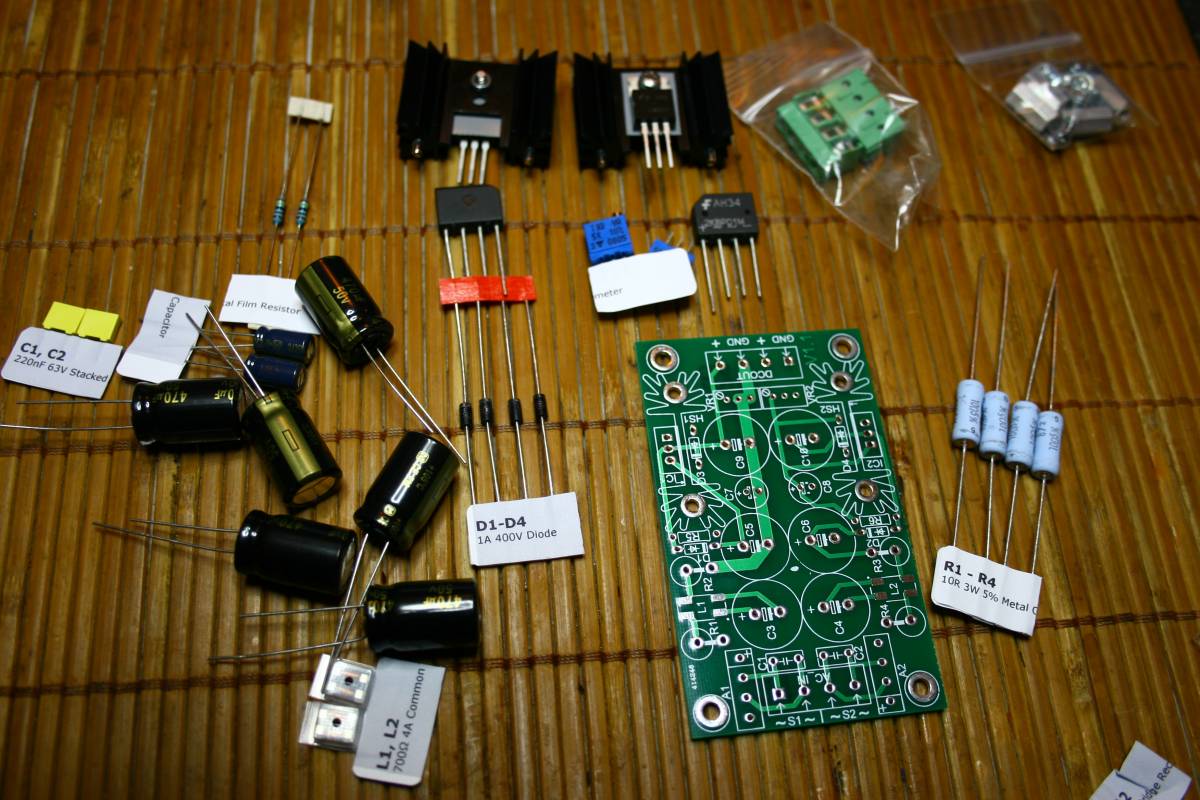
Power supply
comes as a bag of loose parts but PERFECTLY described by silkscreen .
Assembly is easy even for a novice. 15 minutes maximum.
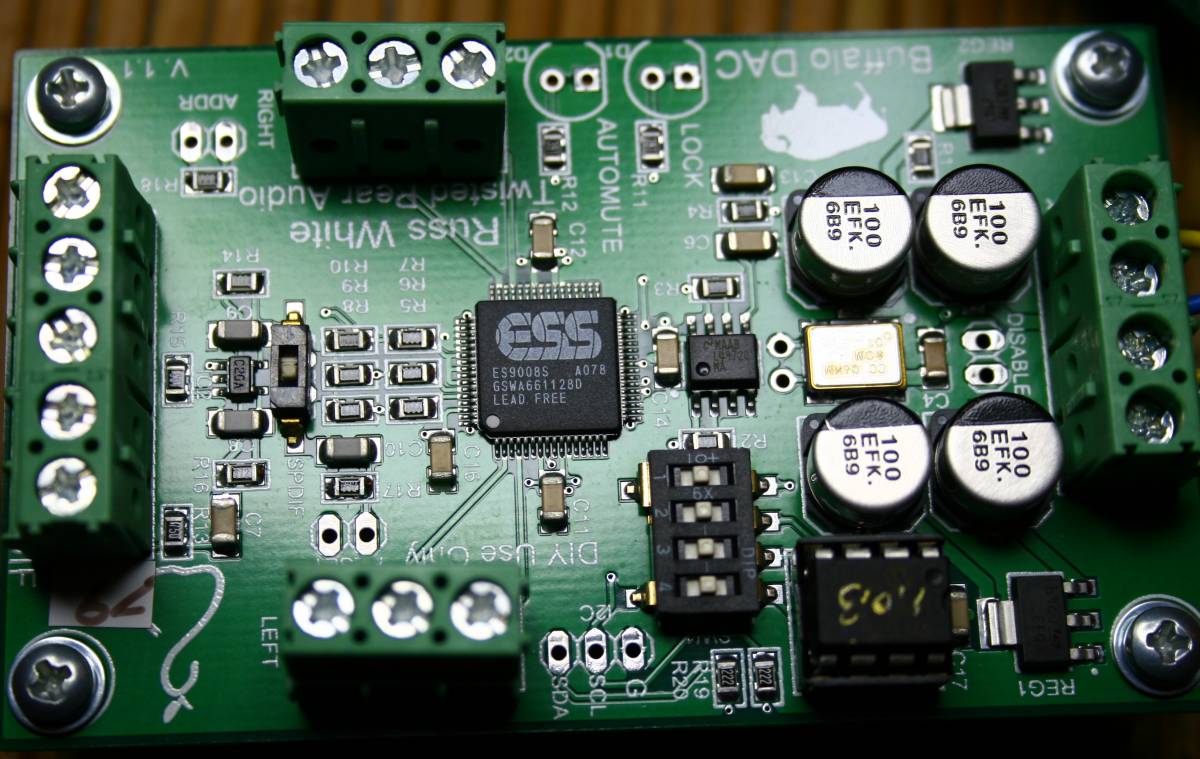
Top view of the
Buffalo and the ESS Sabre on the centre stage
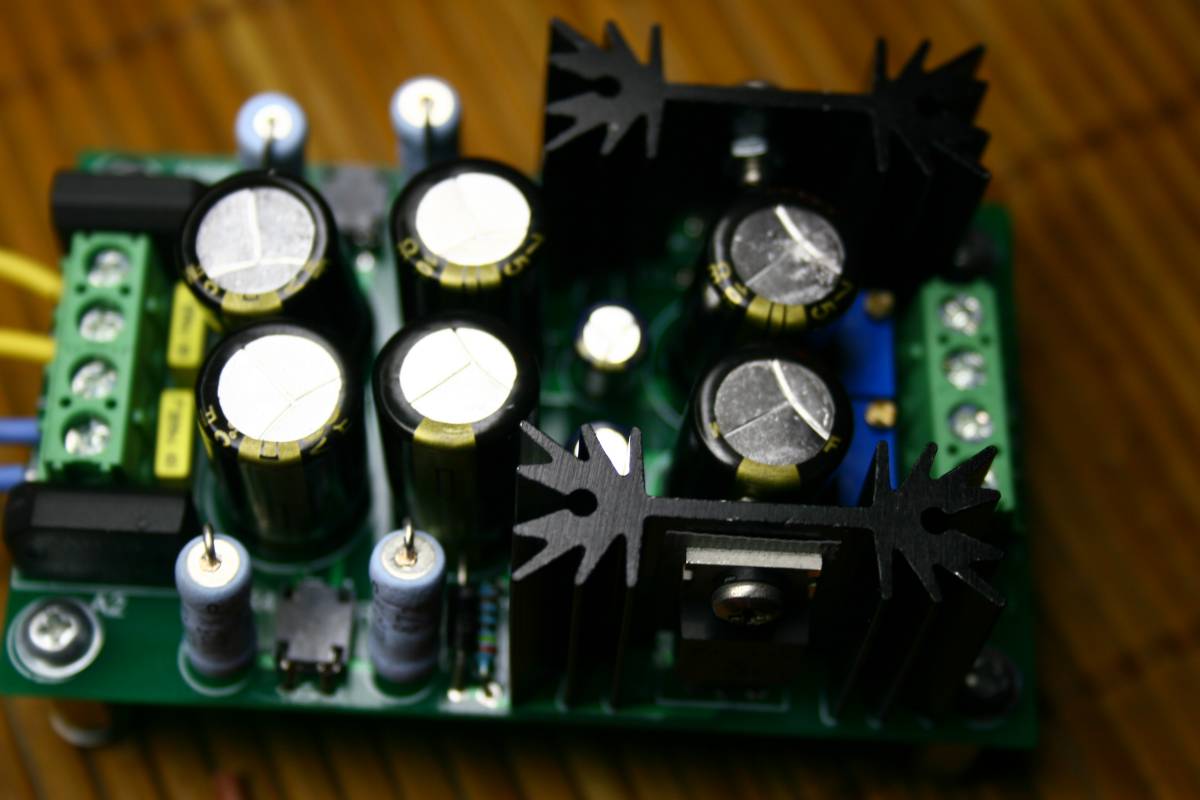
Power supply
ready to sing

What a
perfection of voltage regulation !!!!!!!

Two 12 V AC
lines power the twin power supply unit.
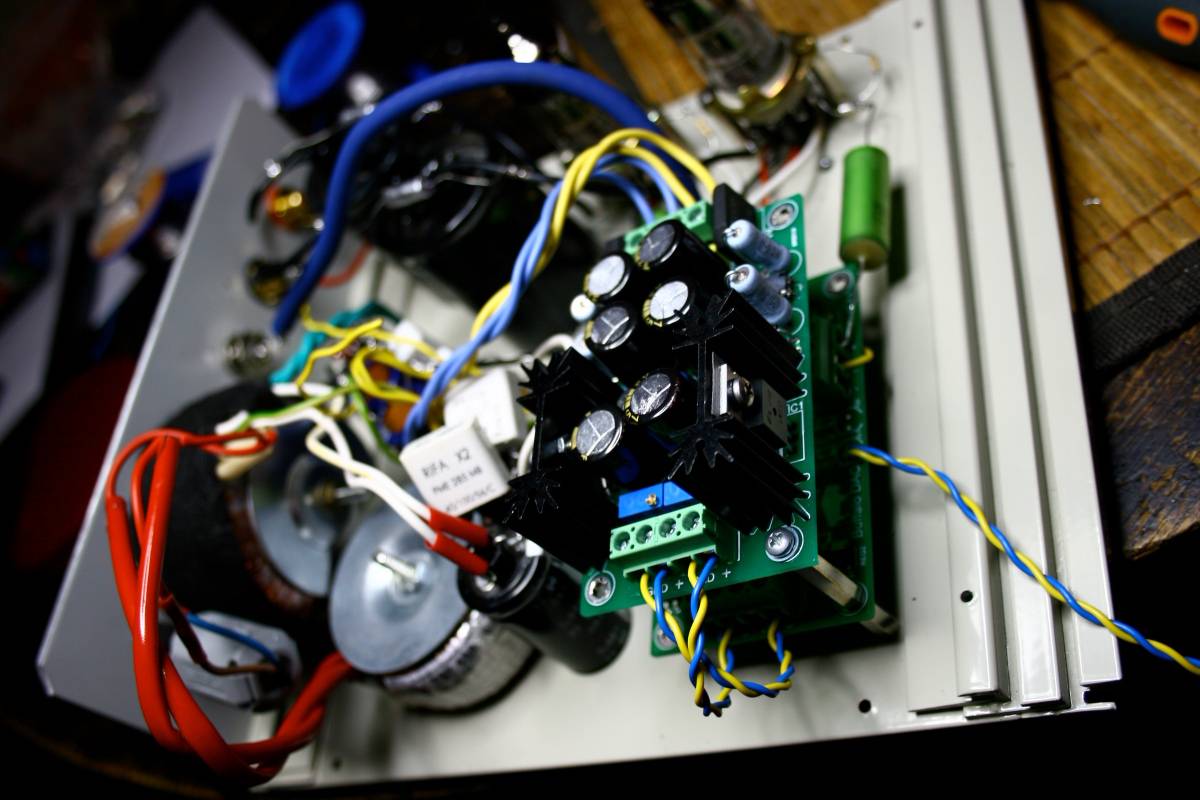
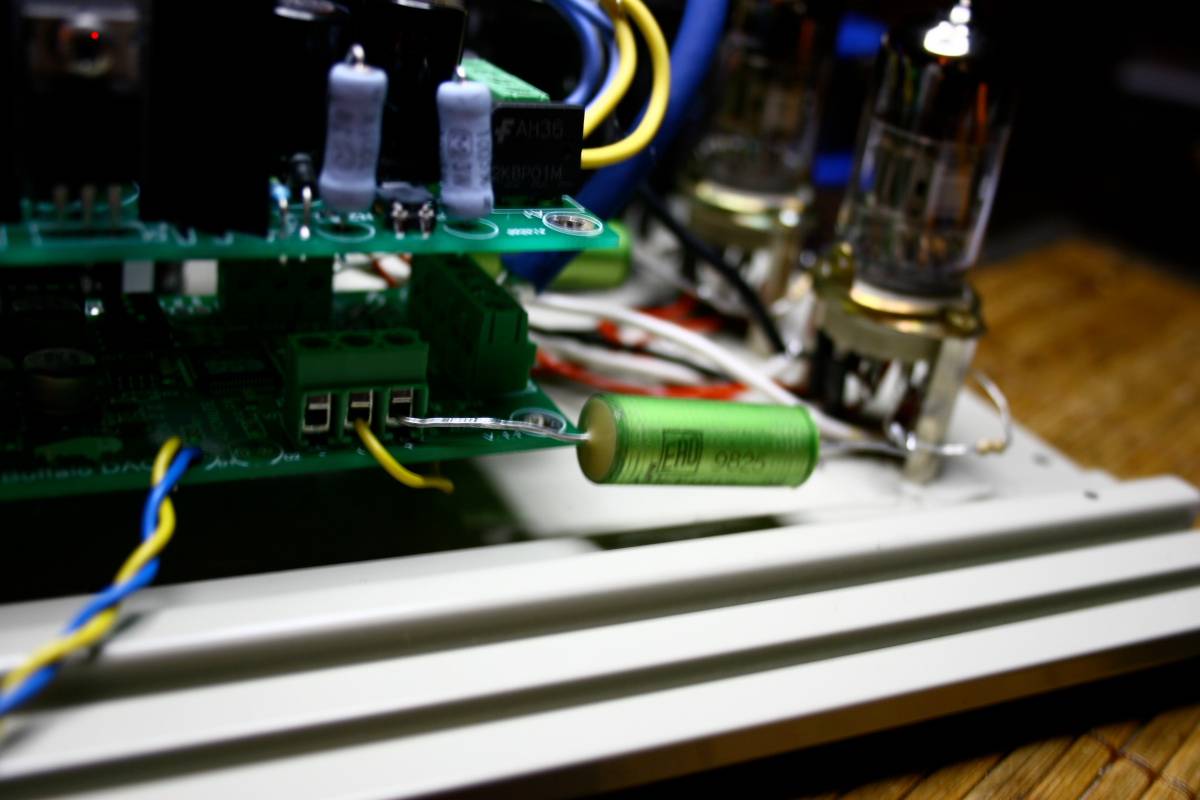
I was
experimenting with various styles of output. First - directly to tube
grid without any caps or resistors. B ut the sound was too loud, much
too loud.
That was the
direct Voltage output mode.
Then I did the
same but via a capacitor - 2,2 uF ROEDENSTEIN to remove DC
component from the grid. Grid should stay at ground potential or lower,
but not higher and Sabre has 1,6 V DC offset.
Then after
consulting Mr. Russ I tried loading the output by resistor 39 Ohms to
pull the output to current mode.
This time again
- no caps. I marginally prefer the latter solution.
Your mileage may
vary.
In all these
experiments I used SRPP config driven by only one leg of the balanced
output of ESS.
In the future I
will use balanced signal and 4 other tube setups.
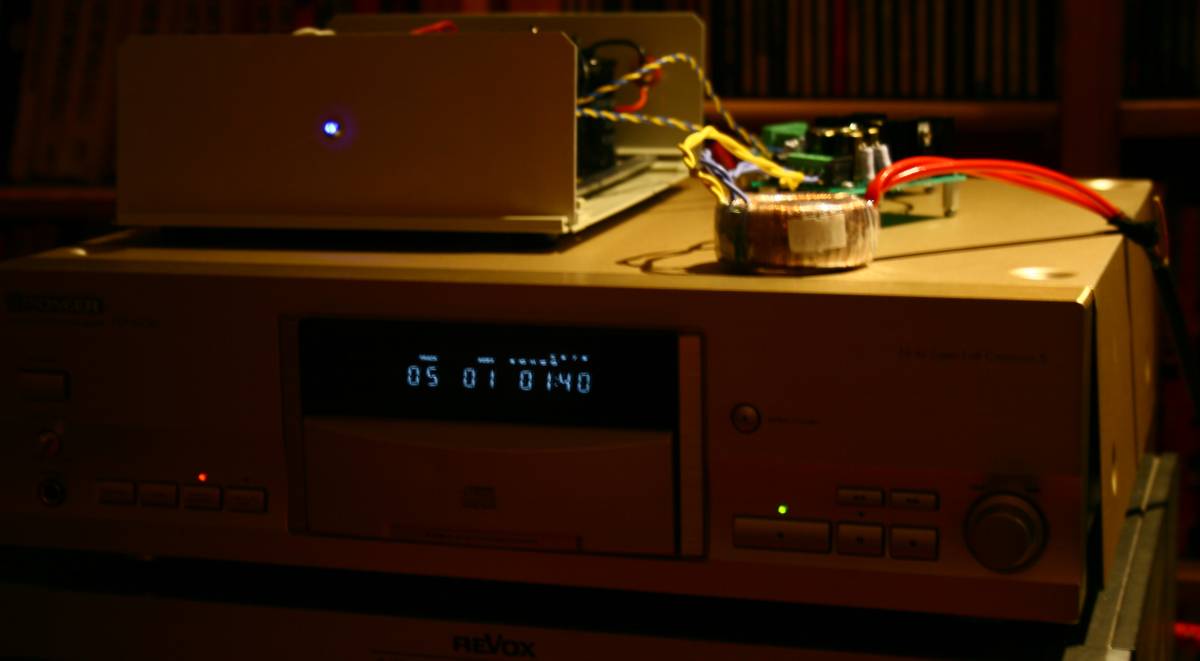
Semi finished
Buffalo Lampizator driven (and compared to) by the Pioneer
superplayer.
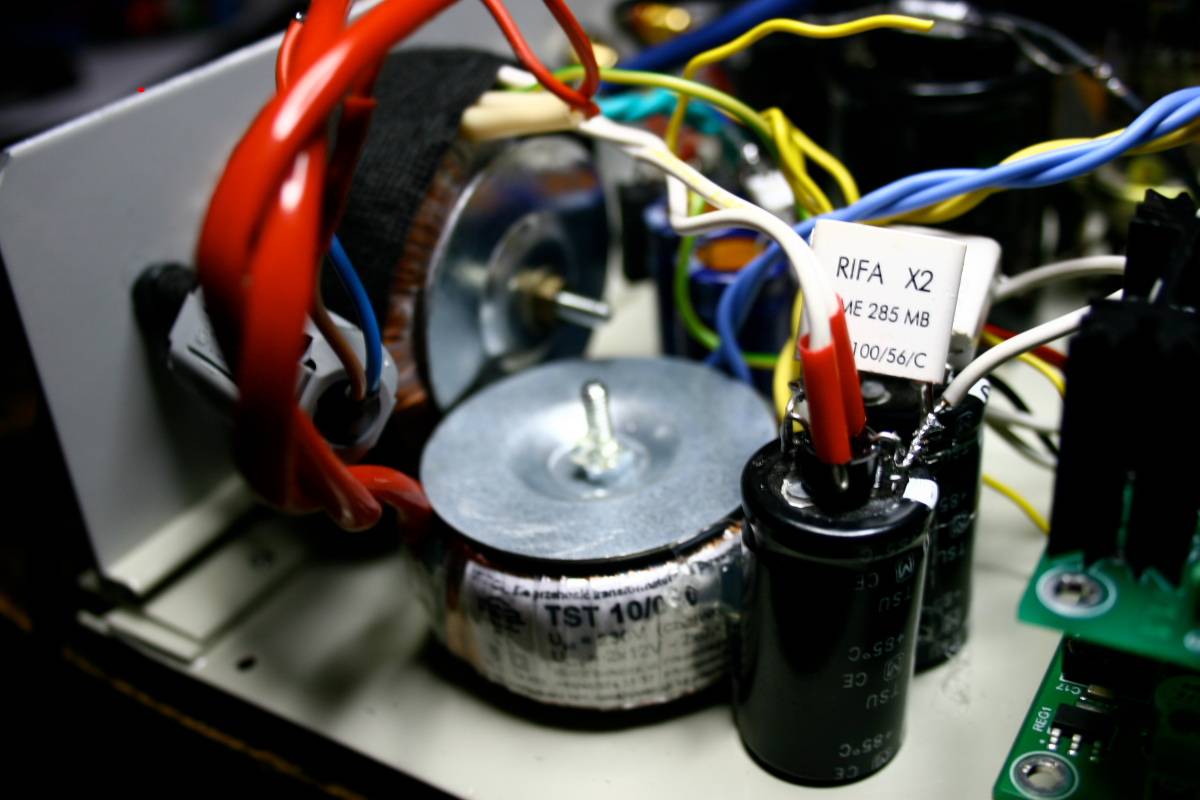
I had to use 2
transformers - one for lampizator and one for DAC.
For the first
time I doubled the anode voltage supply. After connecting two
secondaries in series I got 230 VAC supply line, which after
rectification gives 350 VDC.
Applied to SRPP
with 1,2k resistors it is IDEAL for both 6H6P and 6H2P.
I had 10 mA with
the former and 1 mA with the latter.
Of course the
heater voltage must be adjusted between tube swaps.
The report about
5 other types of lampizator for ESS will follow in mid
december.
Their website:
http://www.twistedpearaudio.com/digital/buffalo.aspx
and the ESS Sabre
DAC history - paper from manufacturer:
Side note from
Internet:
FREMONT, Calif., Aug. 27 /PRNewswire/ -- ESS Technology, a leading
provider of high performance audio/video solutions, today announced that its
Sabre Premier 8-channel Audio DAC is shipping in volume in Samsung's new
4th Generation Blu-Ray Player, BD-P2550.
Audio enthusiasts will appreciate the true studio quality, exceptionally
wide sound stage and unmatched clarity of the BD-P2550's 7.1-channel analog
audio output powered by the ESS Sabre Premier audio DAC (ES9006). With
patented Hyperstream(TM) architecture and Revolver Dynamic Matching, the Sabre
Premier delivers the best-in-class performance of any Blu-Ray player in the
market with up to groundbreaking 120dB dynamic range and -102dB total harmonic
distortion. In addition, a patented time-domain Jitter Eliminator allows
Sabre Premier to reproduce audio free from clock jitter common in digital
interconnect such as S/PDIF and HDMI.
Robert Wong, vice-president of marketing and worldwide sales for ESS
Technology, commented, "Most audiophiles prefer a high performance analog
audio option instead of digital when it comes to high fidelity music and sound
reproduction. Using ESS Sabre Premier Audio DAC ES9006, Samsung is now able
to deliver audiophile-worthy 7.1 channels analog performance in a consumer
Blu-Ray player."
The Samsung BD-P2550 Blu-Ray player
ES9018 32 bit
Esstech DAC Sabre32 Reference arrived - the first
test in Poland. Maybe , who knows the first test in Europe. Possibly -
the first lampized Esstech ES9018 in the World ?
Anybody having
information about the 32 bit Esstech Sabre being tested
with tube-out prior to february, friday the 13th of 2009 - please let
me know.
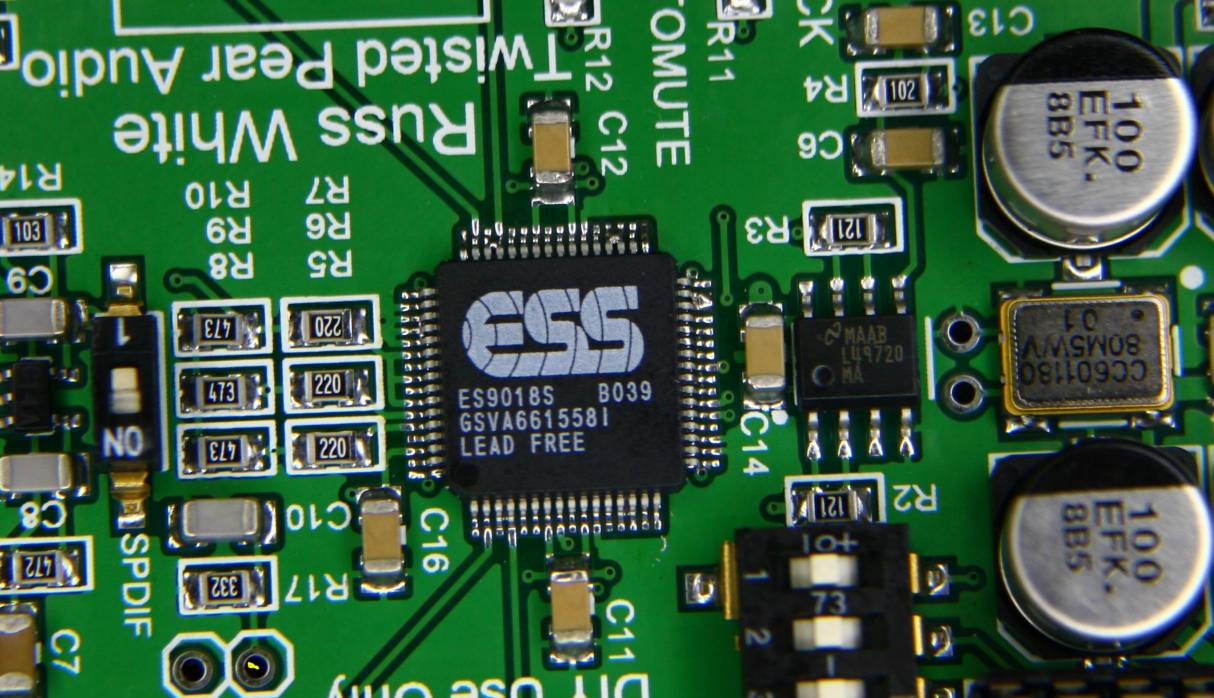
I feel a
huge unbearable responsibility be ing honored with the
first ever evaluation of this DAC. I still consider their predecessor -
ES9008 to be the world's best DAC chip, and so beautifully applied by
Twisted Pear guys.
So quickly,
before the world got accustomed to the new reference, an
even BETTER reference arrived - the ES9018.
Usually I hate
that these days everything comes out NEW AND IMPROVED
every 6 months, I like to get used to what I already like. Andy Warhol
said the same some time ago, when he got irritated going to Macy's to
get a sixpack of his favoirite undies and he found them to be new and
improved. How can a pair of pants get so improved when it is already
nice and comfy ? What 's the point?
Anyway back to
the ESS baby - I could not resist the challenge to be
the reviewer of this product and when it arrived on my desk - a
beautiful fedex from Fermont CA - I nearly fainted. I had to quit my
job and rush home to my lab. One hour later the ESS DAC ended up in the
twisted pear PCB and in my Lampizator-in-a-Box.
Associated
equipment:
ARG mono block
OTL amps 6C33C-B - balanced all the way
Alphard DaVinci
XLR cables
Theta Universal
transport
Home brew 4 way
speakers - OB with all Alnico speakers: ARO Tesla Bass,
420 Biflex Lansing midbass, Isophon Oval Alnico mids and RAAL ribbon
tweeters.
ES9018 applied
with twisted pear supply, (upgraded to all os-
con) and amplified by my own analog stage : Quadruple SE Triode
Anode Follower Balanced Lampizator with 6N8C (6SN7GT) Russian metalbase
tubes (A.D. 1953)
Our first
night together
According to the
nice guys from ESSTECH labs, the new dac is a) pin compatible with the
"old" one, and b) better sounding.
How could that
be?
My first
impression 30 s after hitting the PLAY button was: ok, I already know
it is not worse than the old one. In other words, IMMEDIATELY the
absolute correctness of that sound became apparent.
Without any
direct comparison: ES9018 does something important in the process SO
WELL that the music becomes much much more credible and right. My own
thoughts are "oh so that's how his is supposed to sound, so THATS how
it was recorded. So this is the instrument I never understood. These
are the lyrics I could not get before, so easy to understand now. "
This DAC is
about hearing the music from a new angle, in a different light.
If a high definition term can be applied here, this is the first ever
HD dac. All others were PAL, better or worse - but PAL. This is
the DAc for the blue ray era.
As far as my
memory serves, since CD player was invented, there was not one single
real breakthrough in technology: the first mechanism CDM-0 was not
beaten or improved till now, also the first DAC chips - TDA1540
and 1541A were arguably only equalled, not definitely beaten by the
pletorrhea of chips that followed.
Only SACD was
the first serious attempt on technological advance, a major step up.
Now if you ask
me, I think that ESSTECH people applied their science to make a NEW
kind of DAC. Not merely a "PCM-1704 but better" if you know what I
mean. They must have found something new, such large is the quality gap
from the second best.
In other words -
In my opinion this DAC is the first major technological progress since
the 1982. A real contribution to the HIFI progress.
What excites me
that this is achieved without the use of silver wires, silver
transformers, air-pump suspension, blackgates, and any of that. The
whole secret is in the silicone circuit of a size of sugar crystal
which sits inside the chip. The engineering the way I like it,
not snake oil and voodoo.
ES9018 is a dac
with balanced U output so at first I applied it without any analog
stage. Just directly the DAC to XLR outputs. You don't need to buy any
IVY analog section. This DAC will rock the house on its own. The
sound quality is Okay, but not mind-blowing. Better to listen to it as
it is, and save the IVY money for lampization proper.
My application
of lampizator is not optimal - I used what I had readily available:
Quadruple SE Triode
Anode Follower Balanced Lampizator with 6N8C (6SN7GT) Russian metalbase
tubes. Just two tubes, each half serving as the triode amp. Bear in
mind that these tubes are prohibitively expensive.
I used this:
Power supply 170
V DC
Anode resistor
10K/2W
Cathode
resistor: 330 Ohms/ 1/4W
Grid to ground
resistor 300K
ESS outputs
connected to grids without any resistor in series or parallel - just
open ended via a capacitor - 2,2 uF ERO Roedenstein MKS
Output caps are
Polish Military PIO 1 uF.
So I ended up
with two tubes, four halves as triodes in anode follower scheme.
No cathode
bypass cap at all.
I am still
testing various options.
Sound
characteristics in brief:
1. Above all and
any other feature: un-be-lie-va-ble ability to hear what is going on
2. Absolute
illusion of the scene being "connected" as one realistic event just in
front of you.
3. BASS is
better than any bass I heard before by a good margin.
4. Middle range
is comparable and equal to the best ones I know. Midrange is the
only area where the other DACS can play the game - maybe Wolfson, maybe
TDA1541A, maybe TDA1540, or CS4397 - could be comparable.
5. Highs are
slightly better than any one I know, with CS4397 being second best.
6. Overall
"goosebump" effect is second to none.
7. The ability
to produce scary sounds BEHIND my listening point is really to be
admired (and this time it is not my wife vacuuming the house).
Some other good
points:
Easiness of
application - You don't have to build the big sophisticated equipment
to enjoy the sound of Sabre32 Reference - just a couple of easy pieces
to be connected - piece of cake even for poets and philosophers.
Repeatable
quality: since no hand wound step up transformers are involved here
etc. - every time everybody will get same results. It is a no brainer.
I2S input will
sound even better - please do convert your transport - it is just 3
wires from the SAA7220 chip.
The quality in
my opinion is not a matter of taste, like in the case of TDA1541A.
ES9018 will please everybody.
Some bad points:
To buy this
thing you must patiently wait in line hoping that Mister Monopolist -
Russ White - will have mercy and maybe sell you one. I don't know about
you, but I hate standing in line.
Another bad
point is that the Lampizator is not readily available for this DAC, so
to reach Nirvana - like I did last night - one must solder a tube
circuit
himself.
Honestly
speaking - without tubes - dont bother.
1. ES9018 against
the second best DAC that I have totay at hand - LITE
DAC-AH Lampized
OK, the LITE
DAC-AH is a nice PCB with eight chips parallel TDA1543 - almost as good
as one TDA1541A. When lampized it plays in analogue fashion, the
soundstage is a little fuzzy, the sound is somewhat lacking precision
but it is energetic and full of "meat". Similar to the TDA1540P.
The Sabre32 DAC is better without doubt in every area, mainly overall
transparency and presision. This is no contest. The bass slam, the
depth, the width of scene, the air, the plankton - everything.
2. ES9018 against
the older brother ES9008 version from last year
The taste and
feeling is same in both DACs. The older one is really great, but they
do differ. The newer chip does everything that the old one does well,
but a little bit better. There is more air, more light in the scene, it
is less cold, less sterile, and more magical. I dont think that the
owners of the old Buffalo should RUSH to upgrade but at the same time -
I bet they will. Because audiophilia is such mental state of mind.
The difference
is best compared to the same dac being connected by two digital cables
- a normal coax and a great digital cable. So the sound seems the same,
but better at the same time. If you ask me - I am staying with the new
Sabre32.
3. ES9018 against
the best CD player I know of - Sony CDP555ESD
with clock, NOS and Lampizator
4. Sabre / Buffalo
against the Audio Note DAC 4 Se Silver and Hot
Rodded to almost DAC5 (AD1865 DAC).
5. Sabre32 ES9018
Reference/ Buffalo
against the Audio Note DAC 2 Hot
Rodded to almost DAC3 se with PCM63 DAC chips.
This was a
difficult battle, after one swap I liked more the Sabre32, another swap
and I liked the A-N more. And so it went. We played the usual stuff,
Henry Texier, Leslie Feist, Flanger, Friedman/Liebzeit, Mari Boine,
Beady Belle, Roger Waters, Mercan Dede, Eva Cassidy - all of
them. Overall one listener preferred the "magic" of the A-N and I
preferred the silky smooth precision of the Sabre32. A-N seemed to
lesser degree separate the threads, keeping the total unity of
the musical event. At the same time- threads seemed a little congested,
and in comparison - a little bit dirty. The way a club concert is dirty
but real at the same time.
Sabre32 played
more in high-end fashion - with precision of the eye surgeon, and with
better clarity, fidelity and plankton reality. A really close call. I
know PCM63P - it is a nice dac but not magical, so I attribute the
ultra high quality of this product to the signal transformers (Sowters
I believe, made for A-N) and to the Audionote copper in oil caps and
also some blackgates. If I was hard pressed - I would go for the
Sabre32 and work on improving the tube section, wiring (not silver) and
power supply. The Sabre32 supply was a stock Buffalo PS, which is not
as great as I originally thought. It is merely and Okay regulator stage
but nowhere near the Audionote "five transistor in series"
regulation. I want to say, that chip per chip - the Sabre is MUCH
better than PCM63P but Audionote execution is impeccable, unlike my
quick and dirty test set-up of the Sabre32. I almost know the
result against the bigger Audio-Note DAC4 - (next week) it is gonna be
extremely tough.
Second Sabre32 DAC is built for my friend Loredana: the second look
at the lampization proves successful.
May 09
I decided to try and use my last available Sabre dac to build a cost no
object DAC to rival the best ones out there.
I mean cost almost no object. I did not use chokes in power supply, no
tube rectification of high voltage and no silver wiring, and the case
is - well - rather basic. It is a .... "recession" case
really. But who cares if it plays well.
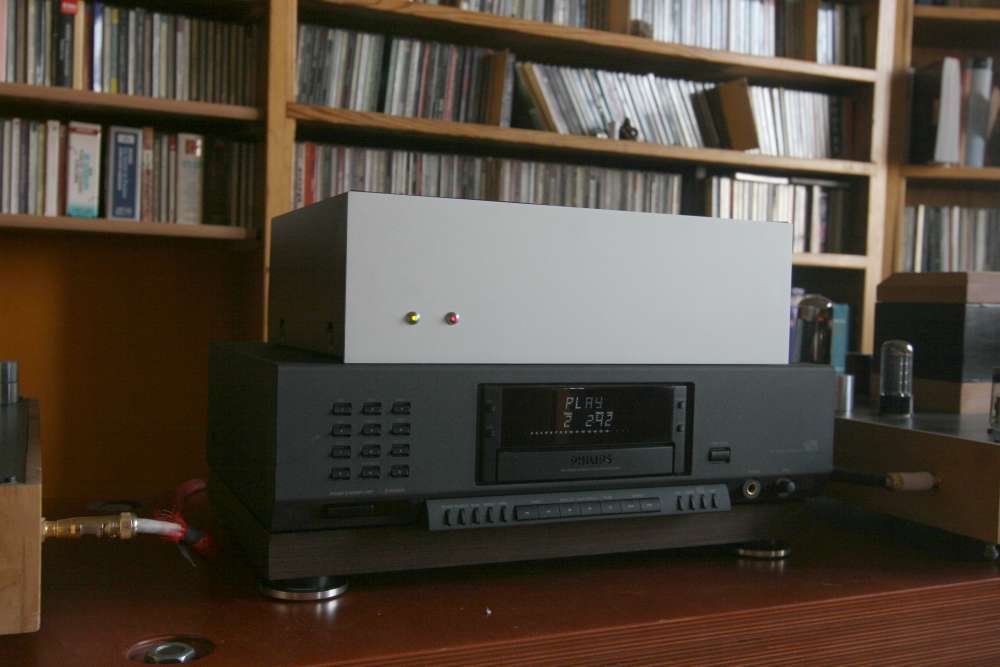
Ready DAC on endless testing session with Fikus Transport.
Green LED is a SIGNAL LOCK indicator, red LED is - "current flow
in anode circuit " Rocket science ! It lits after tube warm-up.
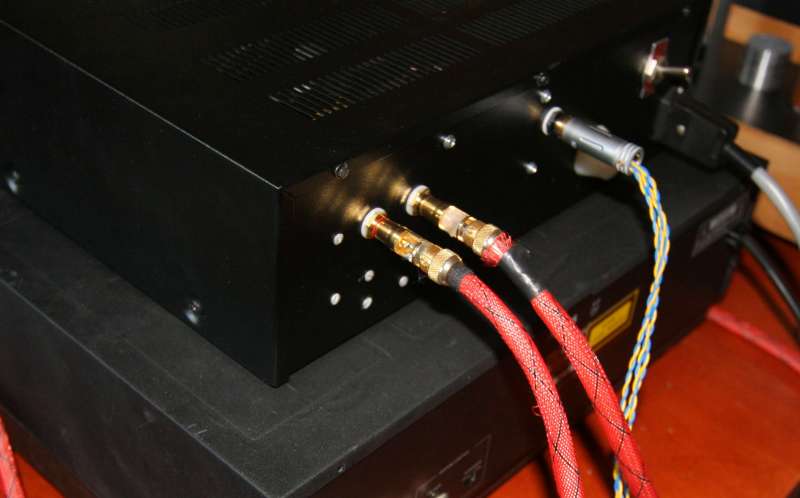
I could have done the I2S and AES/EBU and analog XLR but I chose just
the basic connections: SPDIF and RCA analog.
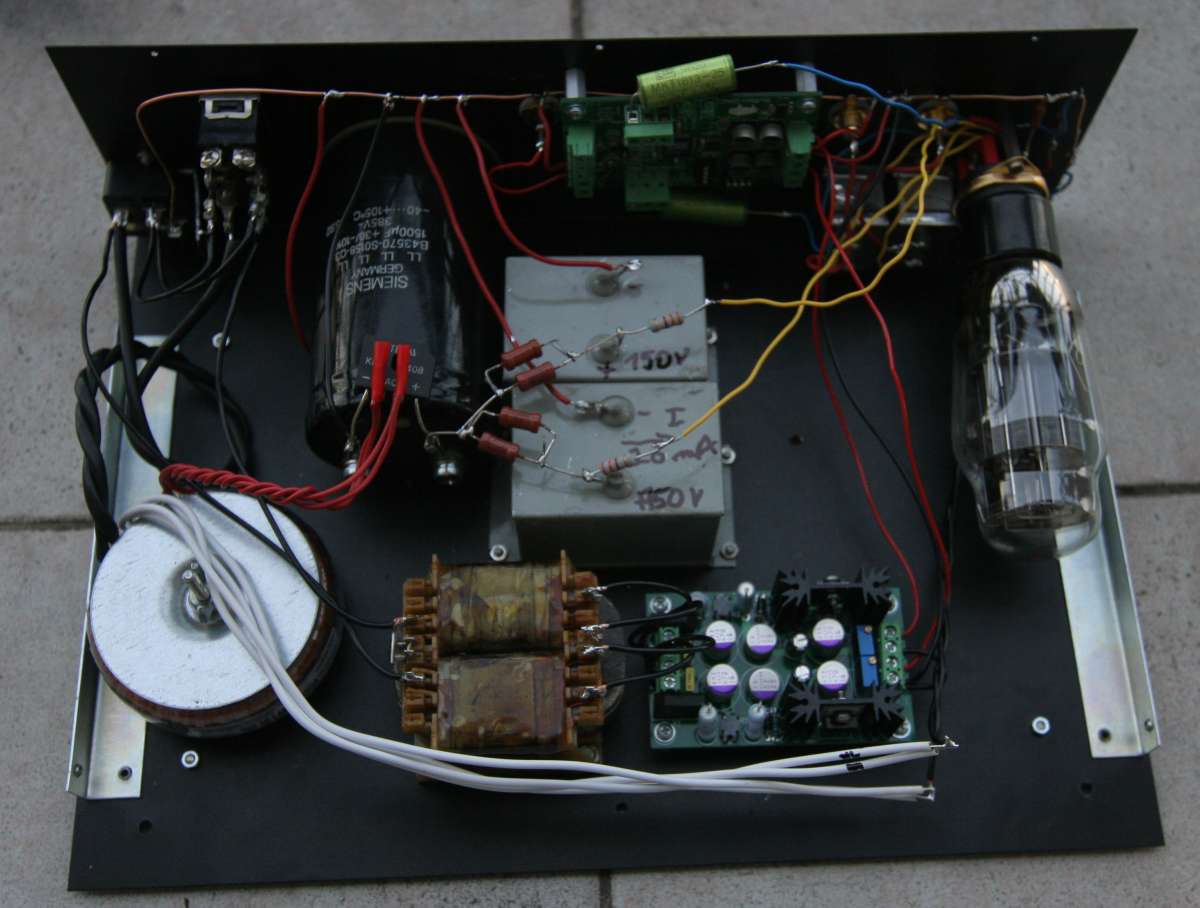
The power supply is monstrous: it uses two transformers, totalling 100
VA (10 x oversize) and the DAC power supply has 2 secondaries 9 VAC 1,6
A each (again - 10 x oversize) The Twisted pear power
regulator boards are assembled by myself with OS-CON SEPC the best caps
I can get. (the six silver/purple cans).
Output is adjusted to 6,3 V DC.
The tube is heated with AC because it is just one tube in dual triode
mode.
The anode power comes from this gigantic siemens cap I found on one
auction - 1500 uF by 380 V. Very nice cap. It is able to play music 4
minutes after power is switched off!.
This cap feeds two stereo paper in oil Polish army caps - 10 uF/ 400 V
and these feed the anode B+ circuits.
The DAC is used in balanced mode - for the first time I connected the
second output to the cathode of tube. This allows for better use of the
balanced topology at virtually no cost. See schematics below. It
plays definitely better than just simple plain triode mode with one
phase to grid.
I tried first the 6H13C super triode - as on the photo) and result was
nice but too mellow and too relaxed. I call this solution elsewhere - a
Megalampizator.
I converted the circuit to another octal - the russian 6H8C and bingo -
this is PERFECT combination. This tube is an equivalent 1:1 with 6SN7GT
so you can try any RCA or Sylvania you want.
My tube is the 1954 metalbase, famous for the most liquid and ear
friendly tonal spectrum on earth. It was produced in the darkest days
of Stalinism by poor people locked in the labour camps in their secret
military "cities" like Ulyanovsk 17th or Semipalatinsk 9th or something
like that. These tubes were DEFINITELY not meant to play music, oh no.
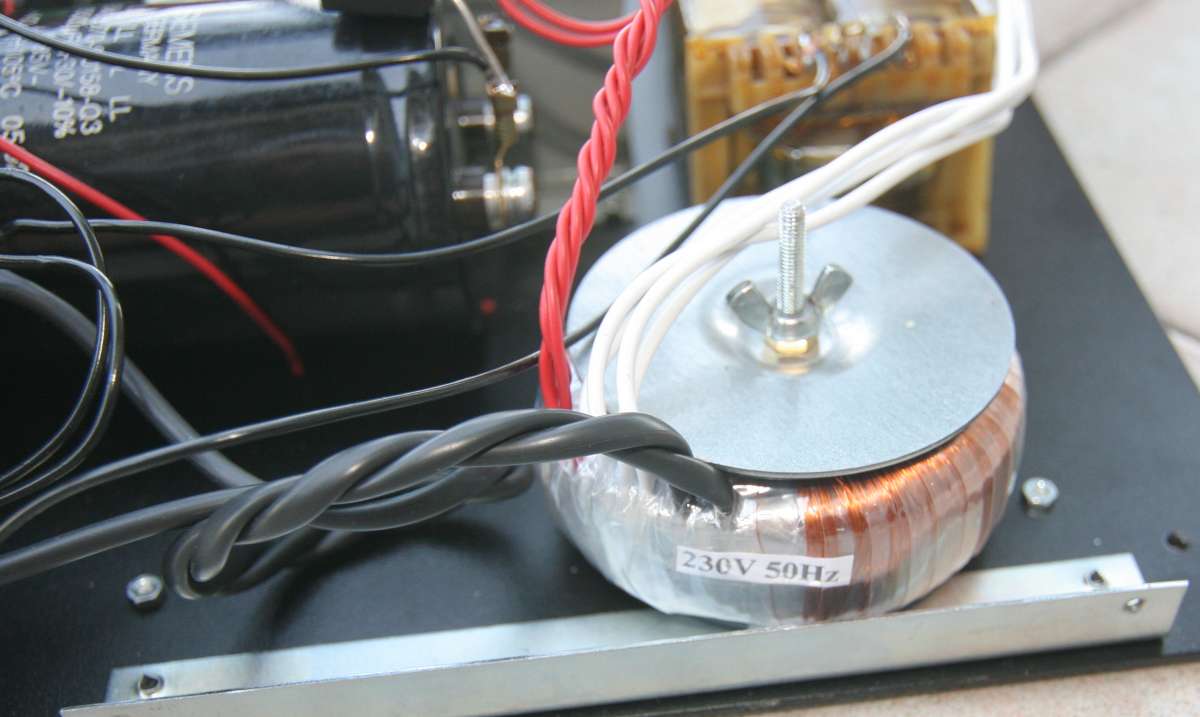
This is the "tube" transformer.
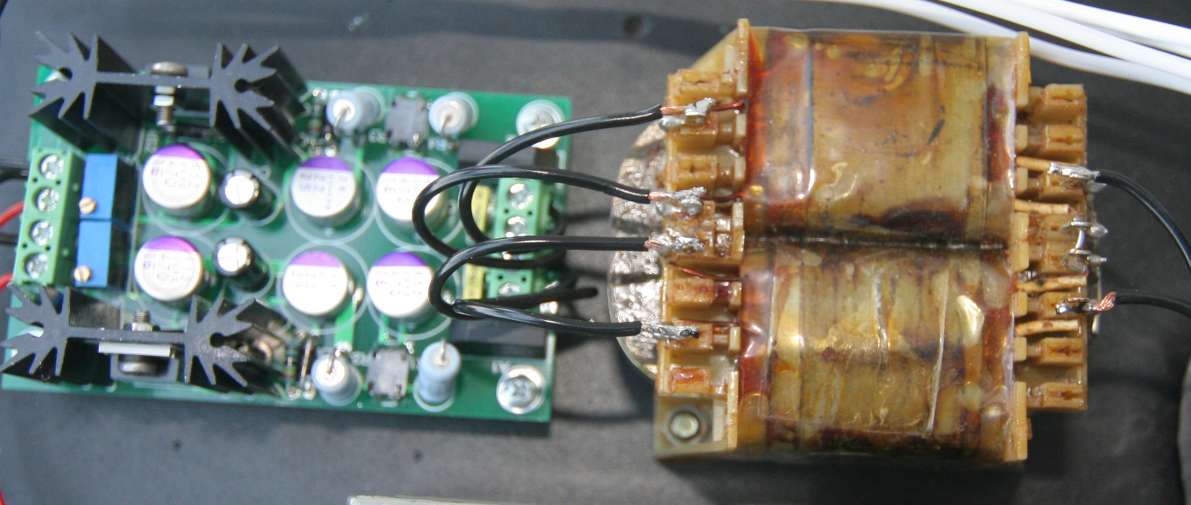
The transformer may look ugly, but it is a great one. 2 x 9 VAC / 1,65
A on a C core.
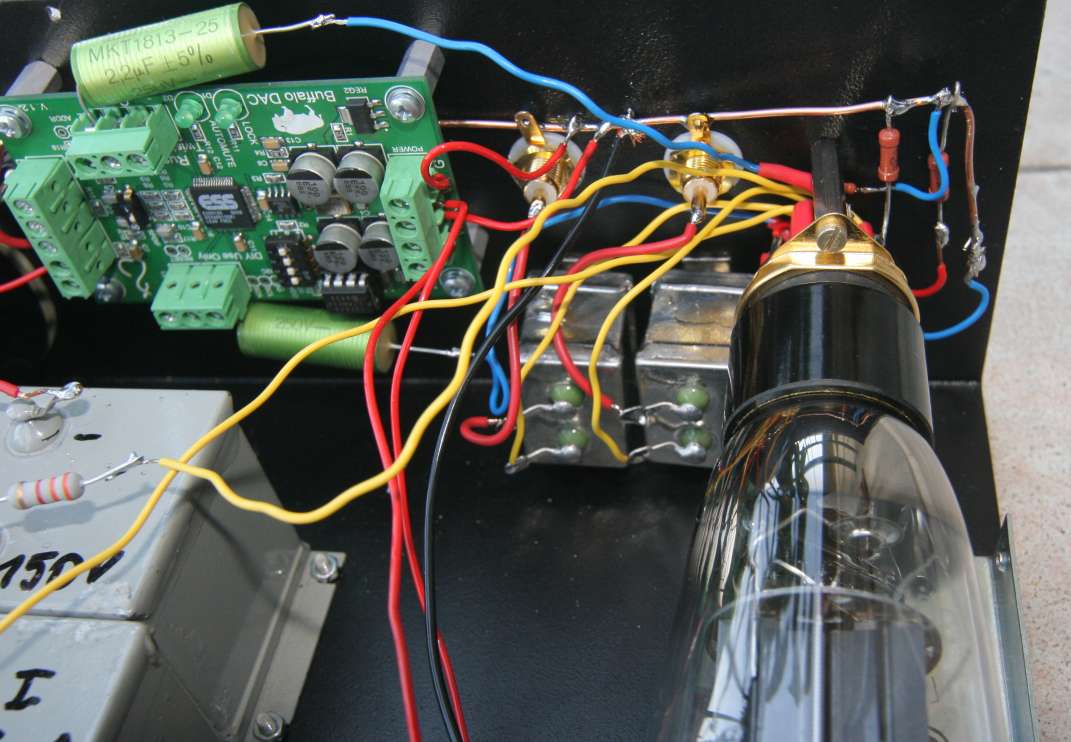
The output caps are the two silver cans - paper in oils again from
Polish TELPOD. While not the copper Jensens, they are very good
for what I use them here.
Note that BOTH phases of the Buffalo output has now a capacitor and a
link to tube, not just one as on the photo.
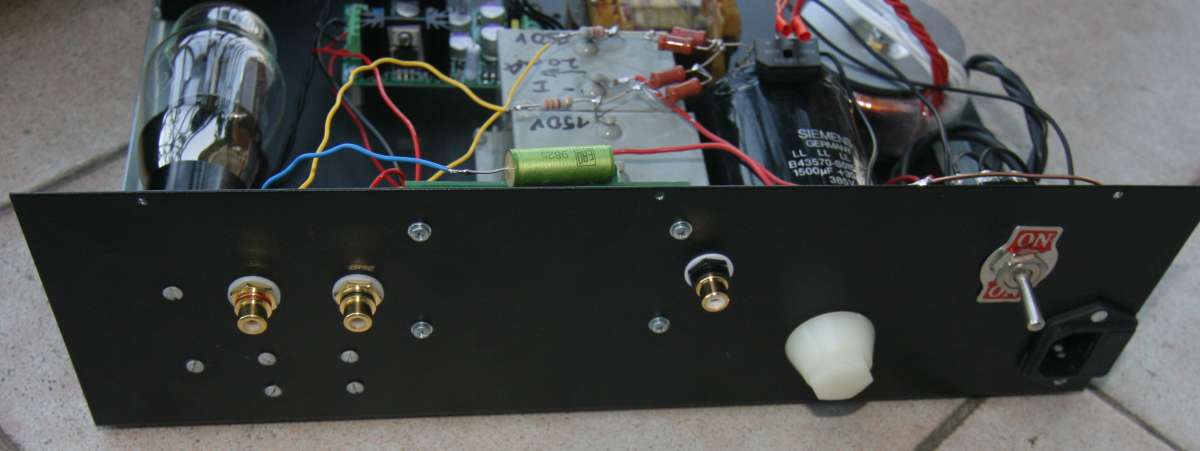
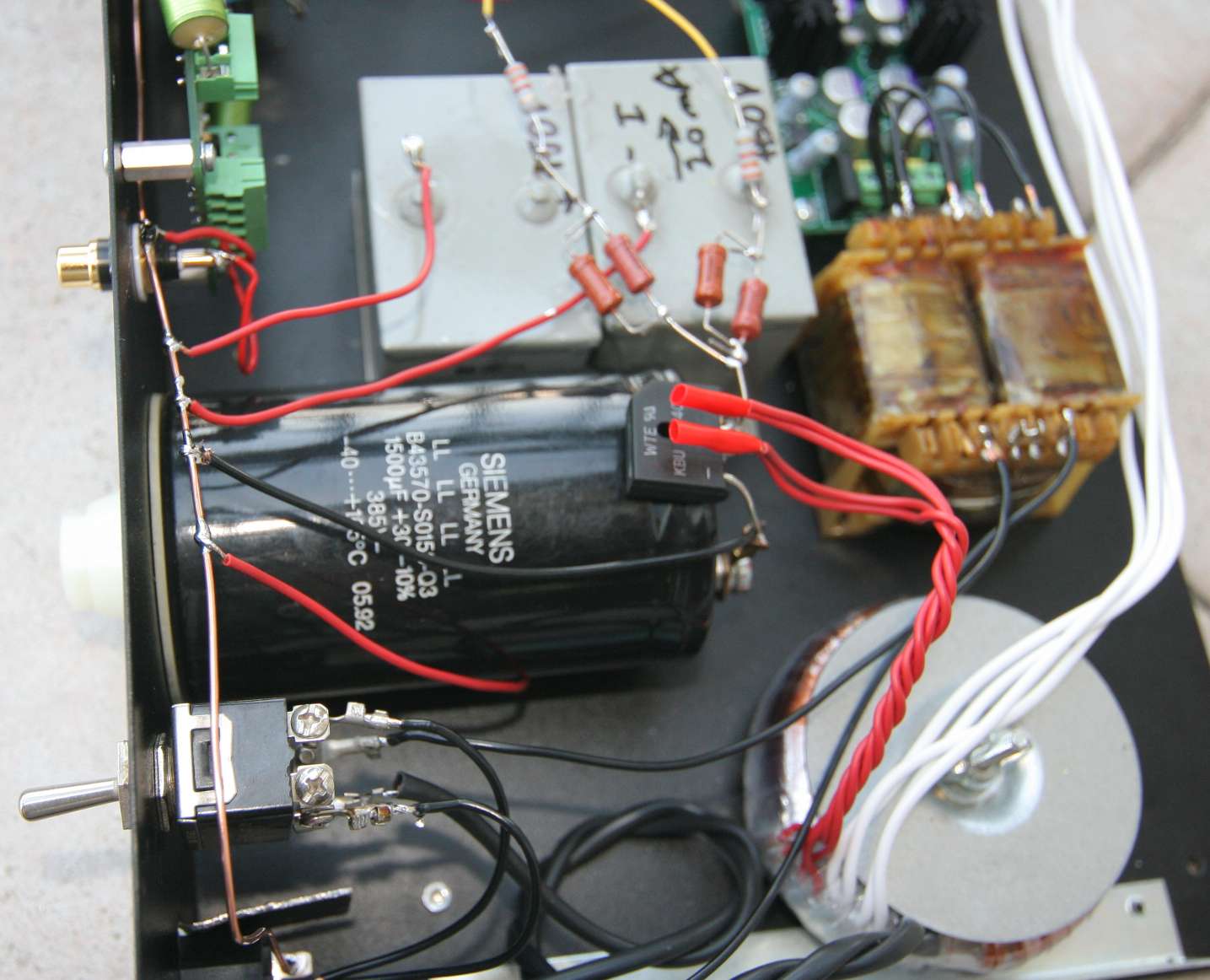

The specs above are given for normal components, not considering the
CRAZY capacitor like 1500/385 which is my joke. I had to use it but you
can safely use a regular electrolyte. Better to spend money on a 50 mA
/ 20 H choke in place of the R1 resistors.
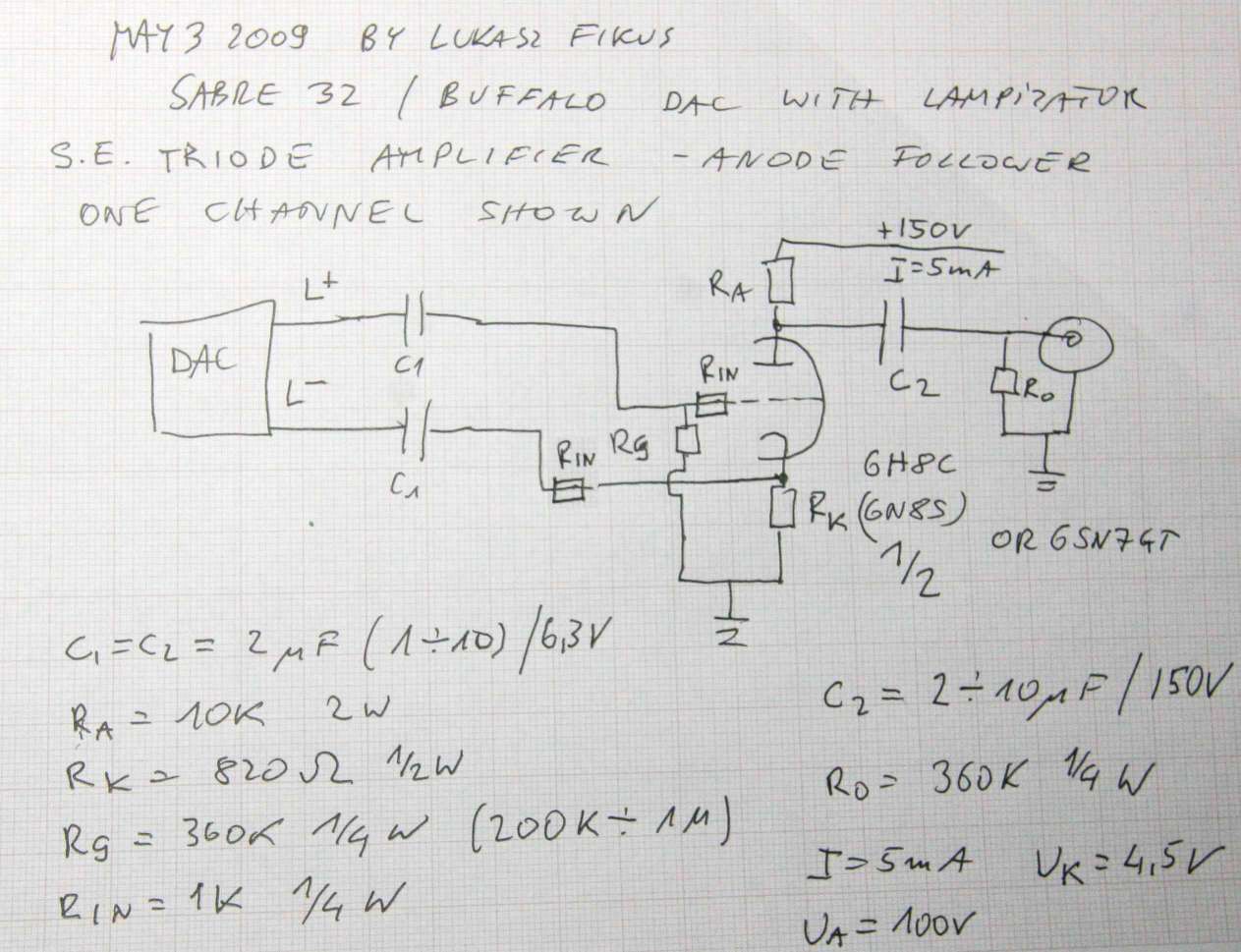
This scheme is really cool. Simple, plain, tricky, kosher and easy to
make. I recommend it to all Lampucera users and for other balanced U
out dacs.
Ze sound.
The strengths of the Buffalo Sabre32 are very nicely underlined in this
dac. Nothing is left to obscure the pure sound. The power supply is big
one, simple and clean. The output tube config is purist as hell. In my
very transparent and very revealing system this DAC shines like a
diamond. The sensation I hear brings to my mind associations like :
Mountain spring air in the morning, cool San Pellegrino water on a hot
day in Milano, Ear cleanup with Q-tips while my wife is not watching, a
glass of 100 dollar Seghesio Zinfandel in the evening by the fireplace
with a piece of goat cheese. Only good associations with purity,
clarity and pleasure. I cant even describe it properly. It is my
favourite DAC with the Wolfson and TDA1541 being close second best.
I am now wondering why Mr. Brian and Mr. Russ elevated the PCB price
from 230 to over 500 USD ? Thats the only problem for me, preventing me
from
wholehearted recommendation.
Is it the cost of two opamps they added? Or cost of 6 oscons they
added? Maybe it is the law of supply and demand equilibrium, the
micro economic theorem of perfect competition.
In this case it is high time that someone else started making the
boards for poorer audiophiles, because Twisted Pear is drifting towards
German Dentist DIY. Time will tell what the market response will be,
but
I am sure there are other people who know how to make a PCB.
In order to have the second critical opinion, at least - more critical
than my own - I gave this DAC for 48 hours to a friendly
audio maniac who is critical as hell. He replaced the Audio Note
AN-3,1X
DAC in his CEC belt drive combo.
He liked the Sabre32 DAC very much and he commented that the Sabre
Lapizator beat the Audio-Note DAC3,1X so badly, it wasn't even
funny. I take his word for it. Next I will try to compare it to
the top Tube Technology Fulcrum DAC. and eventually - the Audio Note 4
SE ( tweaked to almost 5) .
A little later - I tried the upsampler from Behringer - and here
is the report
UPDATE about the latest Twisted Pear Buffalo board version 2
The latest Twisted Pear board with Esstech DAC is "improved" by the
addition of the output stage. 6 opamps that I counted.
Unfortunately, unlike with the first board, there is no connection for
us Lampizators to the naked DAC output. TP added their opamp
based analog stage. The bitter truth is that it sucks. The music is
bad, mechanical, closed in, not high end at all. Compared to the first
board with tube stage or with Sowter transformers - the new board does
not cut it at all. And there is no possibility to cheat the board
easily and add tube stage. It takes a MAJOR rework including the
removal of all opamps.
Guys - you overdone the good product, I am sorry. I must warn all tube
fans folks
who are excited by the ESSTECH DAC to stay away from your buffalo.
I seriously suggest to produce the old board with newest chip and
continue to provide naked output terminals like before. You CAN'T
change reality and stop musically sensitive people from using tubes, it
is impossible. Ah of course - I havent even touched the price
issue ;-)



















